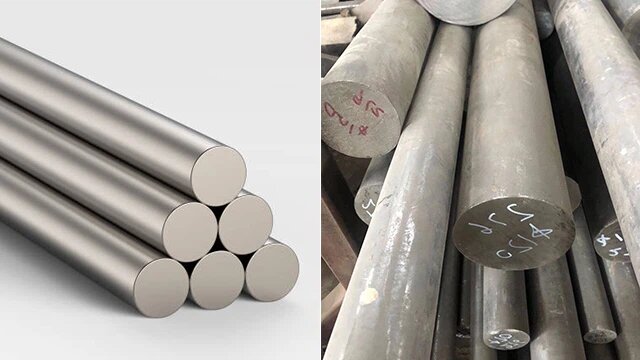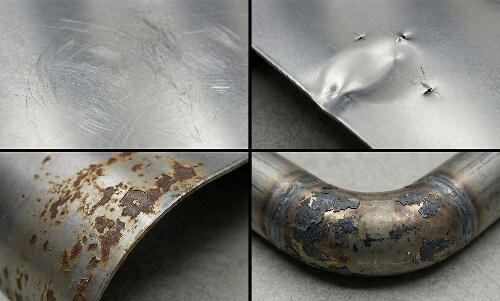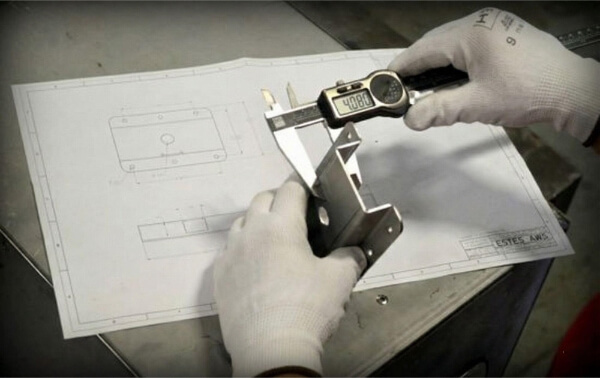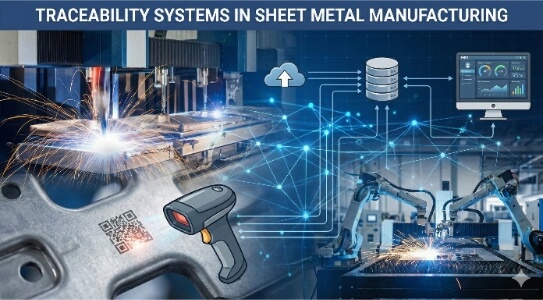Le choix du métal a une incidence sur la durabilité, le coût et les performances du produit. Les ingénieurs sont souvent confrontés à des difficultés lorsqu'ils doivent choisir entre un alliage et un acier inoxydable pour leurs projets. Un mauvais choix de matériau augmente les coûts de maintenance, la défaillance prématurée des pièces et les retards du projet. Le bon choix d'acier optimise à la fois les performances et le budget.
L'acier allié et l'acier inoxydable ont tous deux des fonctions distinctes dans la fabrication. L'acier allié combine le fer avec le chrome, le nickel et le molybdène pour améliorer la résistance et la dureté. L'acier inoxydable contient au moins 10,5% de chrome, ce qui crée une couche d'oxyde protectrice qui empêche la corrosion. Chaque type d'acier excelle dans des applications spécifiques.
Les différences entre ces métaux vont au-delà de leur composition de base. Examinons leurs propriétés uniques, leurs applications et leurs coûts afin de vous aider à prendre une décision pour votre prochain projet.

Définition de l'acier allié
Épine dorsale de la fabrication moderne, l'acier allié représente un mélange précis de fer, de carbone et d'autres éléments conçus pour atteindre des caractéristiques de performance spécifiques.
Composition et caractéristiques
L'acier allié résulte du mélange de fer avec du carbone et d'autres éléments. La teneur en carbone se situe généralement entre 0,3% et 1,7%. L'ajout de manganèse, de chrome et de nickel transforme l'acier ordinaire en un métal plus résistant et plus adaptable. Le traitement thermique améliore encore ces propriétés, rendant l'acier plus dur et plus durable.
Alliages couramment utilisés
- Acier au chrome-molybdène (4130) : Offre une résistance et une robustesse excellentes
- Acier au nickel-chrome (4340) : Offre une résistance à l'usure et une solidité supérieures
- Acier au manganèse Crée un matériau résistant et durcissant au travail
- Acier au silicium : Améliore les propriétés magnétiques et la résistance électrique
Avantages de l'acier allié par rapport à l'acier inoxydable
- Rentabilité : Coûts de production réduits grâce à la diminution du nombre d'éléments d'alliage
- Rapport résistance/poids plus élevé : Meilleures performances dans les applications structurelles
- Usinage plus facile : Nécessite un outillage et un traitement moins spécialisés
- Meilleure aptitude au traitement thermique : Plus sensible aux processus de durcissement
Définition de l'acier inoxydable
Groupe spécialisé d'alliages d'acier qui associe la solidité à une résistance exceptionnelle à la corrosion par l'ajout d'éléments spécifiques, principalement le chrome.
Composition et caractéristiques
L'acier inoxydable se distingue par sa teneur minimale en chrome de 10,5%. Ce chrome crée une couche d'oxyde invisible à la surface. En cas de rayure, cette couche se reforme automatiquement en présence d'oxygène. Le matériau contient également des quantités variables de nickel, de molybdène et d'autres éléments afin d'améliorer certaines propriétés.
Types d'acier inoxydable
- Austénitique (série 300) : Les plus courants contiennent 16-26% de chrome et 6-12% de nickel.
- Martensitique (série 400) : Teneur en carbone plus élevée, magnétisme et possibilité de traitement thermique
- Ferritique (série 400) : Contient uniquement du chrome, magnétique mais non traitable thermiquement
- Duplex : Combinaison de structures austénitiques et ferritiques pour une résistance accrue
Avantages de l'acier inoxydable par rapport à l'acier allié
- Résistance supérieure à la corrosion : Résiste à la rouille et à l'oxydation
- Propriétés d'autocicatrisation : La couche d'oxyde se reforme lorsqu'elle est endommagée
- Excellente hygiène : Facile à nettoyer et à désinfecter
- Meilleure résistance aux produits chimiques : Gère les environnements agressifs

Acier allié et acier inoxydable : Comparaison des propriétés
Une analyse détaillée des propriétés physiques et mécaniques révèle comment chaque type d'acier se comporte dans des conditions réelles. Voici une étude comparative de leurs performances.
Résistance et durabilité
L'acier allié présente une résistance à la traction supérieure, atteignant souvent des valeurs 50% plus élevées que les qualités d'acier inoxydable comparables. L'acier allié 4340 traité thermiquement atteint des résistances à la traction supérieures à 280 000 PSI, alors que la plupart des aciers inoxydables atteignent des valeurs maximales d'environ 200 000 PSI. L'acier allié présente également une meilleure résistance à l'usure sous de lourdes charges, ce qui le rend préférable pour les engrenages et les roulements.
Résistance à la corrosion
L'acier inoxydable domine en matière de protection contre la corrosion. Sa couche d'oxyde de chrome assure une protection continue sans traitement supplémentaire. Acier inoxydable de qualité 316 résiste au brouillard salin depuis des décennies, alors que l'acier allié nécessite des revêtements protecteurs qui doivent être entretenus régulièrement. Dans les environnements chimiques, l'acier inoxydable a une durée de vie 5 à 10 fois plus longue.
Ductilité et malléabilité
L'acier inoxydable, en particulier les nuances austénitiques, offre une formabilité supérieure. Ces nuances s'étirent de 40 à 60% avant de se rompre, contre 15 à 30% pour la plupart des aciers alliés. Cette caractéristique rend l'acier inoxydable mieux adapté aux formes complexes et aux opérations d'emboutissage. Cependant, cette ductilité améliorée entraîne des taux d'écrouissage plus élevés, ce qui nécessite des changements d'outils fréquents.
Conductivité thermique
L'acier allié conduit la chaleur plus efficacement que l'acier inoxydable. Sa conductivité thermique est d'environ 45 W/m-K, alors que celle de l'acier inoxydable austénitique est en moyenne de 16 W/m-K. Cette différence a une incidence sur les processus de fabrication et les applications finales, en particulier dans la conception des échangeurs de chaleur ou dans les environnements à haute température.
Applications de l'acier allié
Industrie automobile
- Les vilebrequins en acier allié 4140 résistent à des charges de couple élevées.
- Les engrenages de transmission en acier allié 8620 assurent un transfert de puissance fiable.
- Les éléments de suspension en acier allié 4340 absorbent les chocs de la route.
- Les arbres de transmission nécessitent la résistance à la fatigue d'un acier allié 4130.
Construction et infrastructures
- Les poutres de soutien du pont sont en acier à haute résistance et faiblement allié.
- Les châssis d'équipements lourds dépendent de la durabilité de l'acier allié 4130
- Les barres de renforcement des fondations en acier allié préviennent les défaillances structurelles
- Les composants des grues s'appuient sur la capacité de charge supérieure de l'acier allié
Fabrication et machines
- Les composants de presses industrielles en 4340 supportent des cycles de stress répétés
- Les broches de machines-outils bénéficient de la résistance à l'usure du 4150
- Les bras de robots industriels utilisent les propriétés de cémentation du 8620
- Les pièces du système de convoyage tirent parti du rapport poids/résistance du 4140
Applications de l'acier inoxydable
Industrie alimentaire et des boissons
- Les équipements de cuisine commerciale utilisent des surfaces sanitaires de qualité 304
- Les cuves de brassage doivent être de qualité 316 pour résister à la corrosion
- Les convoyeurs de l'industrie alimentaire préservent la propreté grâce à la qualité 316L
- Les récipients de stockage restent désinfectés grâce à l'acier inoxydable 304L.
Équipement médical
- Les instruments chirurgicaux exigent la dureté et la stérilité du grade 420
- Les composants des appareils d'IRM utilisent 316 pour ses propriétés non magnétiques
- Les outils dentaires s'appuient sur la rétention des arêtes en 440A
- L'équipement de laboratoire bénéficie de la résistance chimique du 316L
Utilisations dans l'aérospatiale et l'automobile
- Les systèmes d'échappement utilisent la qualité 409 pour la résistance à la chaleur.
- Les fixations aéronautiques requièrent la haute résistance du 17-4 PH
- Les composants du système d'alimentation en carburant dépendent de la résistance à la corrosion du 316
- Les supports structuraux utilisent le 301 pour sa capacité de durcissement par écrouissage.

Analyse de coût
Le choix des matières premières a une incidence sur les dépenses immédiates et la planification financière à long terme des projets de fabrication. Voici une analyse comparative des coûts des deux métaux.
Coûts initiaux de l'alliage par rapport à l'acier inoxydable
L'acier allié coûte généralement 40-60% de moins que les qualités d'acier inoxydable comparables. Une tonne d'acier allié 4140 coûte en moyenne 1T4T1 200, tandis que l'acier inoxydable 304 coûte environ 1T4T3 000 par tonne. Les coûts de transformation diffèrent également : les machines pour l'acier allié sont plus rapides, ce qui réduit les frais de main-d'œuvre et d'outillage. Cependant, les exigences en matière de revêtement ajoutent 15-25% au coût final des composants en acier allié.
Coûts de maintenance à long terme
L'acier inoxydable s'avère plus économique au fil du temps dans les environnements corrosifs. Alors que l'acier allié doit être repeint ou recouvert tous les 2 ou 3 ans, l'acier inoxydable conserve sa protection sans intervention. Les applications marines révèlent des différences flagrantes : les pièces en acier allié doivent être remplacées trois fois plus souvent que les pièces en acier inoxydable en raison des dommages causés par la corrosion.
Considérations sur les coûts et les avantages
Le choix entre ces matériaux doit faire l'objet d'une analyse minutieuse. Les applications soumises à de fortes contraintes favorisent l'acier allié en raison de son coût initial plus faible et de sa résistance supérieure. Un fabricant d'engrenages typique économise 30% en choisissant l'acier allié plutôt que l'acier inoxydable. Cependant, les équipements de transformation des aliments fabriqués en acier inoxydable réduisent les risques de contamination et les coûts de nettoyage de 40% par an par rapport aux alternatives en acier allié revêtu.
Fabrication et usinage
Les méthodes de fabrication et les caractéristiques d'usinage influencent considérablement l'efficacité de la production et la qualité des pièces finales. Une exploration de la manière dont ces matériaux se comportent au cours des processus de fabrication et ce à quoi on peut s'attendre en production.
Facilité de fabrication de l'acier allié
L'acier allié répond bien aux méthodes de fabrication standard. La plupart des nuances sont coupées proprement avec un outillage conventionnel à des vitesses standard, et le matériau soudures facilement avec des procédures de préchauffage et de refroidissement appropriées. Les températures de fabrication courantes sont comprises entre 1600°F et 2200°F.
Le traitement en atelier s'avère simple. Le matériau se forme de manière prévisible avec un équipement de presse plieuse standard. Les opérations de coupe nécessitent une compensation modérée de l'usure de l'outil. Finition de surface suit des processus standard sans nécessiter de traitement particulier.
Traitement thermique ajoute de la polyvalence à la fabrication. Le matériau accepte diverses méthodes de durcissement pour améliorer ses propriétés. La réduction des contraintes après le soudage permet de maintenir la stabilité dimensionnelle. Les traitements post-fabrication améliorent la résistance à l'usure si nécessaire.
Propriétés d'usinage de l'acier inoxydable
L'acier inoxydable exige des méthodes d'usinage plus prudentes. La durée de vie des outils diminue en raison de l'écrouissage pendant les opérations de coupe. Les vitesses sont généralement inférieures de 20 à 30% à celles de l'acier allié.
La gestion de la chaleur joue un rôle clé dans la réussite de l'usinage. La formation d'arêtes accumulées nécessite des vitesses plus élevées et un refroidissement adéquat. Le contrôle des copeaux doit faire l'objet d'une attention particulière pour éviter les problèmes d'écrouissage. Des changements d'outils réguliers permettent de maintenir la qualité des pièces.
Le soudage nécessite des procédures et des métaux d'apport spécifiques. Des surfaces propres et un blindage gazeux adéquat empêchent la contamination. Le nettoyage après soudage élimine la teinte de la chaleur et rétablit la résistance à la corrosion.
Quelles sont les similitudes entre l'acier allié et l'acier inoxydable ?
Les deux matériaux ont pour point de départ une base fer-carbone. Leur structure moléculaire fondamentale repose sur cette base. Le processus de fabrication commence de la même manière pour les deux types, impliquant un contrôle minutieux de la chaleur et des ajouts précis d'éléments.
Un autre trait commun est la souplesse de fabrication. Les deux métaux répondent bien aux normes processus de formage. Coupe, flexionet la jonction fonctionne bien si les paramètres sont correctement réglés.
Les exigences en matière d'outils se chevauchent considérablement. Les deux matériaux nécessitent un outillage en carbure pour obtenir des résultats optimaux. L'équipement standard d'un atelier d'usinage fonctionne pour les deux matériaux. Les outils manuels de base et les équipements électriques conviennent aux deux types de matériaux lorsqu'ils sont correctement adaptés à la qualité spécifique.
Le traitement thermique améliore les deux matériaux et un contrôle adéquat de la température améliore leurs propriétés. Les deux matériaux réagissent à l'équipement de traitement thermique conventionnel. Des taux de refroidissement judicieux permettent d'obtenir les caractéristiques souhaitées.
Acier allié ou acier inoxydable : Choisir le bon acier pour votre application
Tenez compte de ces facteurs clés lorsque vous choisissez un alliage ou un acier inoxydable pour votre projet.
Exigences de performance
- Les plages de température de fonctionnement dictent le choix du matériau
- Les applications porteuses favorisent la résistance de l'acier allié
- Les environnements corrosifs exigent une protection en acier inoxydable
- Les besoins en matière de résistance à la fatigue varient selon le type d'application
Considérations relatives à la fabrication
- Capacités et équipements d'usinage disponibles
- Spécifications requises pour la finition de la surface
- Exigences en matière de volume de production
- Contraintes liées à la méthode d'assemblage
Facteurs économiques
- Limitation du coût initial des matériaux
- Durée de vie prévue du produit
- Allocations du budget de maintenance
- Estimation de la fréquence des pièces de rechange
Exigences spécifiques à l'industrie
- Respect de la réglementation en matière de sécurité alimentaire
- Spécifications des matériaux de qualité médicale
- Exigences en matière de certification aérospatiale
- Normes de sécurité automobile
Conclusion
Le choix d'un alliage ou d'un acier inoxydable nécessite de trouver un équilibre entre les besoins de performance, les conditions environnementales et les contraintes budgétaires. Chaque matériau remplit des fonctions distinctes dans la fabrication moderne. L'acier allié offre une résistance élevée et un bon rapport coût-efficacité pour les applications structurelles. L'acier inoxydable offre une résistance à la corrosion et un attrait esthétique inégalés. Les exigences spécifiques de votre projet guideront le choix optimal.
Au-delà de la sélection des matériaux, nous proposons des services complets de fabrication de tôles, du prototypage rapide à la production en série. Nos capacités de fabrication avancées en matière de découpe laser, d'usinage CNC et d'emboutissage des métaux garantissent que votre projet répond aux spécifications. Contactez notre équipe d'ingénieurs dès aujourd'hui pour explorer la solution acier optimale pour votre prochain projet.
FAQ
Quelles sont les principales différences entre l'acier allié et l'acier inoxydable ?
L'acier allié associe le fer à divers éléments pour renforcer la résistance et la durabilité ; il coûte moins cher mais nécessite une protection de la surface. L'acier inoxydable contient un minimum de 10,5% de chrome, ce qui lui confère une résistance naturelle à la corrosion grâce à une couche d'oxyde auto-cicatrisante. Si l'acier allié offre une plus grande résistance, l'acier inoxydable offre une meilleure protection contre la corrosion et une meilleure conservation de l'apparence.
Quel type d'acier convient le mieux aux applications à haute température ?
Le choix de l'acier pour les environnements à haute température dépend de la plage de température et des conditions d'exposition. Les aciers alliés tels que le 4140 supportent des températures allant jusqu'à 1000°F tout en conservant leur résistance. Les aciers inoxydables austénitiques résistent à l'écaillage jusqu'à 1600°F et résistent mieux à l'oxydation.
Quels sont les inconvénients de l'acier allié ?
L'acier allié nécessite des traitements de surface ou des revêtements pour la protection contre la corrosion. Ces couches protectrices doivent être régulièrement entretenues et remplacées. Le matériau s'oxyde rapidement lorsqu'il est exposé à l'humidité. Le soudage exige un préchauffage soigneux et un traitement thermique après soudage.
L'acier allié est-il inoxydable ?
L'acier allié rouille s'il n'est pas correctement protégé. Contrairement à l'acier inoxydable, il ne possède pas de couche d'oxyde de chrome autoprotectrice. Les traitements de surface tels que la galvanisation, la peinture ou le revêtement en poudre offrent une protection temporaire contre la rouille. L'entretien régulier et la réapplication de revêtements protecteurs empêchent la formation de rouille.
Hey, je suis Kevin Lee

Au cours des dix dernières années, j'ai été immergé dans diverses formes de fabrication de tôles, partageant ici des idées intéressantes tirées de mes expériences dans divers ateliers.
Prendre contact

Kevin Lee
J'ai plus de dix ans d'expérience professionnelle dans la fabrication de tôles, avec une spécialisation dans la découpe au laser, le pliage, le soudage et les techniques de traitement de surface. En tant que directeur technique chez Shengen, je m'engage à résoudre des problèmes de fabrication complexes et à favoriser l'innovation et la qualité dans chaque projet.




